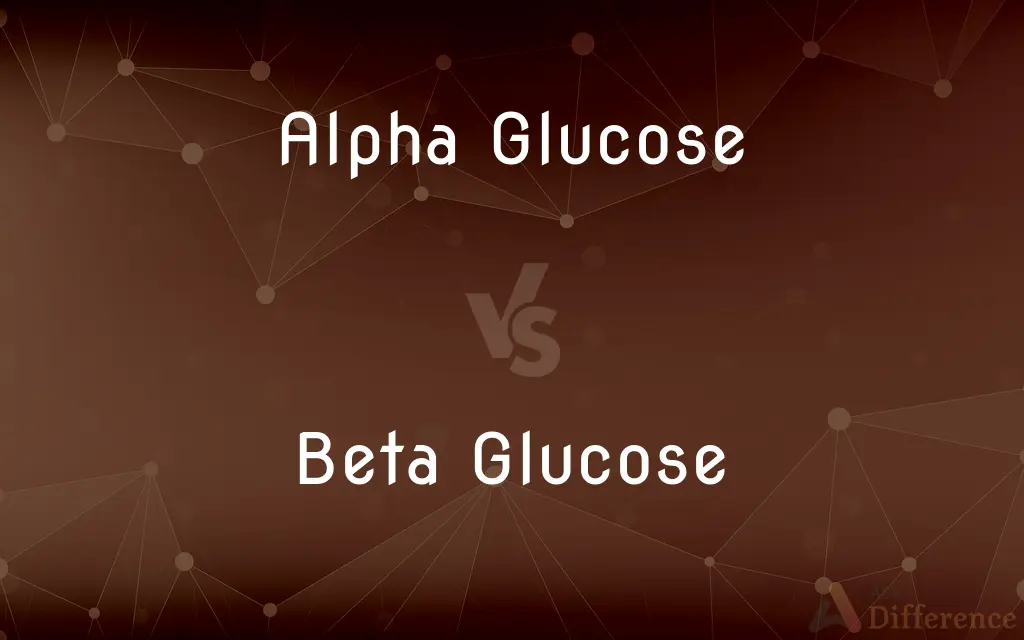Alpha Glucose vs. Beta Glucose — What's the Difference?
By Tayyaba Rehman — Published on December 17, 2023
Alpha Glucose and Beta Glucose are isomeric forms of glucose. In Alpha Glucose, the OH on carbon-1 is below the plane; in Beta Glucose, it's above.

Difference Between Alpha Glucose and Beta Glucose
Table of Contents
ADVERTISEMENT
Key Differences
Alpha Glucose and Beta Glucose are both monosaccharides, but they differ structurally at the anomeric carbon. In the case of Alpha Glucose, the hydroxyl group (OH) attached to the anomeric carbon is positioned below the plane of the glucose molecule. This orientation results in a certain way Alpha Glucose molecules interact and bond with other molecules. Conversely, for Beta Glucose, the hydroxyl group on the anomeric carbon faces above the plane.
This distinction between Alpha Glucose and Beta Glucose might seem minute, but it leads to significant differences in their properties and the polymers they form. When Alpha Glucose molecules bond together, they form the polysaccharide starch, which is a primary storage carbohydrate in plants. In contrast, when Beta Glucose molecules link, they produce cellulose, the most abundant organic polymer on Earth and a key structural component in plant cell walls.
The behavior of these two molecules in water also varies. Alpha Glucose is readily soluble and is often found in its ring form in aqueous solutions. Beta Glucose, due to its different orientation at the anomeric carbon, exhibits different solubility properties. The unique bonding of Beta Glucose in cellulose makes it difficult for most organisms to digest.
Understanding the distinction between Alpha Glucose and Beta Glucose is pivotal in biochemistry and nutrition. While both are forms of glucose and provide energy, the structural difference leads to varied roles in nature. For example, humans can easily digest and utilize the energy from Alpha Glucose found in starch, but most cannot digest Beta Glucose from cellulose, which instead provides dietary fiber.
Comparison Chart
Orientation at Anomeric Carbon
Hydroxyl group (OH) is below the plane
Hydroxyl group (OH) is above the plane
ADVERTISEMENT
Polysaccharide Formation
Forms starch
Forms cellulose
Dietary Role
Easily digestible and provides energy
Mostly indigestible, provides dietary fiber
Solubility in Water
Readily soluble
Different solubility due to bonding in cellulose
Importance
Primary storage carbohydrate in plants
Key structural component in plant cell walls
Compare with Definitions
Alpha Glucose
Monosaccharide forming the polysaccharide starch.
Plants store energy in the form of Alpha Glucose chains.
Beta Glucose
Glucose form providing dietary fiber.
Beta Glucose, as part of cellulose, offers dietary fiber, aiding digestion.
Alpha Glucose
Glucose molecule easily utilized for energy.
Dietary sources rich in Alpha Glucose provide quick energy for cellular functions.
Beta Glucose
Monosaccharide forming the polymer cellulose.
Plants utilize Beta Glucose chains to give structure to their cell walls.
Alpha Glucose
An isomer of glucose with the OH group below the plane.
In Alpha Glucose, the orientation of the hydroxyl group leads to the formation of starch.
Beta Glucose
Key component in plant structural support.
The strength of plant cell walls is attributed to the Beta Glucose chains in cellulose.
Alpha Glucose
Ring-structured sugar soluble in water.
Alpha Glucose readily dissolves in aqueous solutions, favoring its ring form.
Beta Glucose
Mostly indigestible sugar for many organisms.
Humans cannot break down Beta Glucose efficiently, making it a source of fiber.
Alpha Glucose
Primary energy source for many organisms.
Human cells readily metabolize Alpha Glucose for energy during cellular respiration.
Beta Glucose
An isomer of glucose with the OH group above the plane.
The orientation in Beta Glucose results in the formation of cellulose.
Common Curiosities
What major polymer is formed by Beta Glucose?
Beta Glucose forms cellulose.
Can humans easily digest Beta Glucose?
No, humans primarily digest Alpha Glucose, while Beta Glucose provides dietary fiber.
Which form of glucose makes up starch?
Alpha Glucose forms the polysaccharide starch.
Are both forms of glucose sweet-tasting?
Yes, both Alpha Glucose and Beta Glucose are sweet, but they're not used for sweetness in food in their monosaccharide forms.
What's the main structural difference between Alpha Glucose and Beta Glucose?
In Alpha Glucose, the OH on carbon-1 is below the plane; in Beta Glucose, it's above.
How do plants utilize Beta Glucose?
Plants use Beta Glucose to form cellulose, providing structural support to cell walls.
Which glucose form is a major part of plant cell walls?
Beta Glucose is a primary component of plant cell walls due to its role in cellulose.
Do both forms of glucose exist in nature?
Yes, both Alpha Glucose and Beta Glucose naturally occur and have vital roles.
Is Alpha Glucose found in fruits?
Yes, fruits contain Alpha Glucose along with other sugars.
Why is Alpha Glucose important for energy?
Alpha Glucose is easily metabolized for energy in cellular respiration.
Which form of glucose is more prevalent in our diet?
Alpha Glucose, found in starchy foods, is more prevalent in most diets.
Why can't most animals digest cellulose?
Cellulose, made of Beta Glucose, has a unique bond that most animals can't break down.
Can the human body convert one form of glucose to the other?
While both forms can interconvert in chemical reactions, the body primarily metabolizes Alpha Glucose for energy.
Does the difference in structure affect their physical properties?
Yes, the structural difference leads to varied solubilities, digestibility, and functions.
Is Beta Glucose a source of energy for any organisms?
Yes, some microbes can break down Beta Glucose from cellulose for energy.
Share Your Discovery

Previous Comparison
Translator in Programming Language vs. Interpreter in Programming Language
Next Comparison
Cost Accounting vs. Financial AccountingAuthor Spotlight
Written by
Tayyaba RehmanTayyaba Rehman is a distinguished writer, currently serving as a primary contributor to askdifference.com. As a researcher in semantics and etymology, Tayyaba's passion for the complexity of languages and their distinctions has found a perfect home on the platform. Tayyaba delves into the intricacies of language, distinguishing between commonly confused words and phrases, thereby providing clarity for readers worldwide.













































